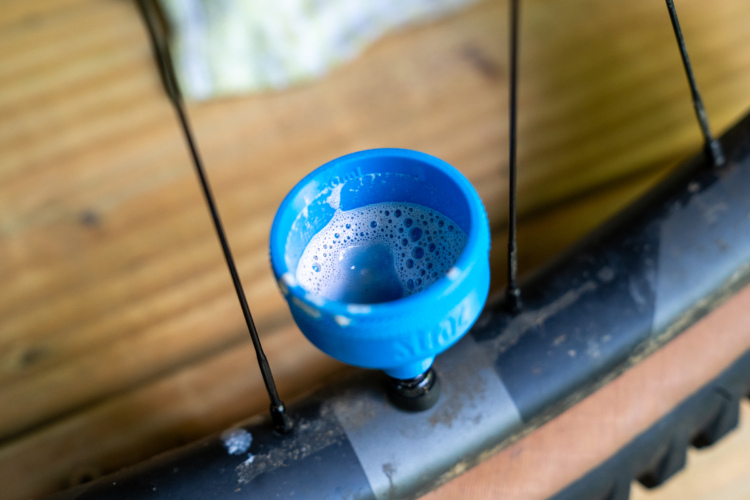
The $50 American Classic Tectonite is a front-specific mountain bike tire that claims to deliver predictable cornering without suffering the traverses and climbs along the way. I’ve been testing the Tectonite on my hardtail this fall and while it’s not perfect, the tire does deliver on most of its promises.
American Classic Tectonite tire specs
The American Classic Tectonite mountain bike tire is listed at 2.5″ wide and comes in 29″ and 27.5″ diameters. Buyers can choose from either a trail or enduro (tested) casing.

The tubeless-ready EN model I tested is constructed with two layers of 120tpi casing plus a layer of additional sidewall protection. This tire uses three different compounds, placing softer but faster-wearing rubber on the side knobs for improved traction.

The tread pattern features two sets of alternating center blocks. The first set has a wide, ramped knob flanked by two smaller, angled, trapezoidal knobs. The second set of center knobs features two rectangular nubs with minimal ramping and wide spacing. Sets of cornering knobs alternate as well, and are aggressively siped. The soft compound, along with the siping, makes these tallish knobs feel supple with little force needed to deform them.
In between the knobs and on the sidewall there’s a fine, repeating texture in the shape of the American Classic logo.
Installation and real world measurements
I had a very hard time getting the American Classic Tectonite tire installed and aired up on my Reynolds carbon wheels. The tire fit on the rim easily — perhaps a bit too easily because the bead just wouldn’t grab the rim and hold air. With my Reynolds wheels I can generally mount tubeless tires using just a floor pump on the first try; the Tectonites woudn’t even mount using an air compressor.
After a couple of hours throwing every trick in the book at these I finally gave in and put a tube inside. Thankfully airing up the tube got the bead to pop into place. I then deflated the tube and carefully unseated just one side of the tire so I could remove the tube. From there I was finally able to air the tire up tubelessly, and it’s been running tubeless ever since.
Reviewer profile height: 190cm (6’3″) weight: 75kg (165lb) testing zone: Southeast, USA
American Classic says the 29×2.5″ EN tire weighs 1210g; my sample tips the scale 60g heavier at 1270g. At about 20psi on 32mm internal width rims, the tire measures 61mm wide (2.4in) which falls shy of the stated 2.5in width. I have yet to find a tire that measures at its full width on 32mm rims so take this with a grain of salt.
On the trail with the American Classic Tectonite

Despite my hiccups getting the Tectonite mounted, there wasn’t much of an initial learning curve on the trail. The tire transitions predictably in the corners and hooks up well thanks to the soft and supple — yet well braced — side knobs. The tire also has a nice profile on 32mm rims that’s neither too square or too round.
The EN construction doesn’t offer as much sidewall stiffness as I would like. I found I needed to add a few psi to my preferred front tire pressure to keep them from feeling soft and floppy in turns. With most tires I can get away with the lighter trail construction, but for the Tectonites I will definitely opt for the tougher enduro version as tested.
The American Classic Tectonite tire delivers good grip in a variety of conditions from dry and loose to damp and leafy. The widely spaced knobs clear mud and clay well enough, though this would not be my choice for riding in truly wet or muddy conditions.
On the climbs and traverses the American Classic Tectonite isn’t a fast or slow roller; it’s pretty much average. The 1,270g weight is average as well, at least for the tire’s intended use and feature set. It spins up to speed with a medium amount of effort and doesn’t weigh down the front end when it’s time to jump.
In spite of the lackluster sidewall stiffness I didn’t pinch flat during my tests, nor did I experience any punctures. I have noticed a gradual loss of pressure every few days, though overall the tire seems to be fairly rugged and durable.
After about six weeks of testing the tire has worn pretty evenly, though the center knobs look a touch more worn than the corners. It likely has many more miles left to go.
Pros and cons of the American Classic Tectonite mountain bike tire
Pros
- Good cornering
- Great price
Cons
- Loose fit makes for difficult tubeless installation
- Needs stiffer sidewalls
Bottom line
The American Classic Tectonite corners better than any mountain bike tire I’ve tested that retails for $50 or less.
- Price: $50
- Buy from Amazon.












3 Comments
Nov 11, 2022
Nov 11, 2022
Nov 9, 2022